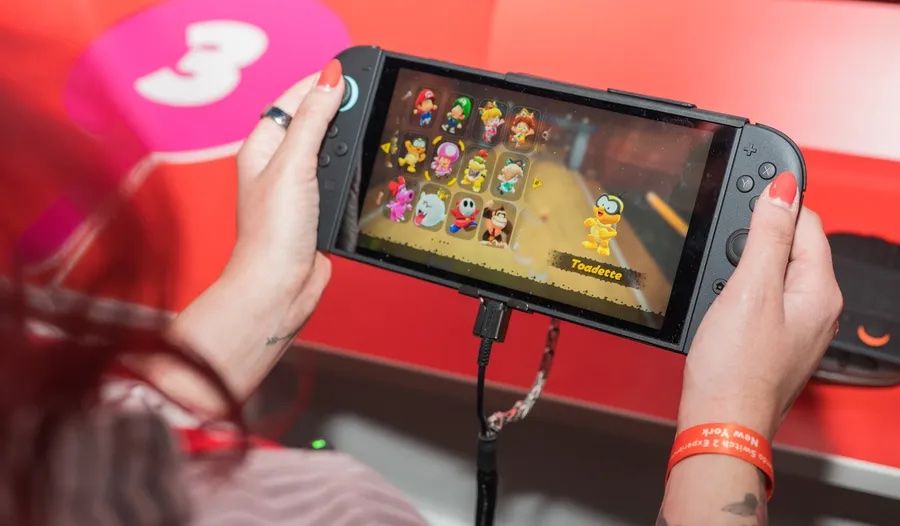the naming of Nintendo’s Switch successor might seem like pretty straightforward choice, but developers say they spent years during the development process, brainstorming names and scrapping them. Eventually producer Kouichi Kawamoto, director Takuhiro Dohta, and technical director Tetsuya Sasaki landed on what was, for them, an unconventional route: the Switch 2.
They first discussed calling it the Super Nintendo Switch, Kawamoto told media during a private event held in New York City, paying homage to the jump from the original Nintendo to the Super Nintendo console—but there was an important distinction. The NES and SNES do not share compatibility between their games.
“We wanted to make sure that the name really reflected the idea that this is the latest Nintendo Switch, this is the latest standard, a new standard for what Nintendo Switch is,” Kawamoto said.
After a few hours spent with the hybrid handheld during a hands-on event, that description feels appropriate. The Switch 2 is not a leap forward, as the original Switch was from the Wii U, but rather a product of iteration. It’s a collection of ideas and designs, refined, to create a product that feels both familiar and improved from its predecessor.
Mario Kart World is the Switch 2’s key launch game.
Photograph: Julian Chokkatu
It’s bigger. Nintendo has increased the handheld’s size from the original 6.2-inch screen to a 7.9-inch LCD display and magnetized its Joy-Con controllers, which are also slightly longer to accommodate the change. In my hands, the difference was barely noticeable. The Switch 2 feels comfortable to hold and play as a handheld, neither too heavy nor too clunky; I’ve had more difficult tactile upgrades with my iPhone.
At the event, I played the newly announced Mario Kart World both on the console itself and on a TV with the Joy-Cons attached to a Joy-Con grip. I’ve always preferred the original system’s handheld mode, and the experience of playing on the Switch 2 is much the same.
Photograph: Julian Chokkatu
Photograph: Julian Chokkatu
Photograph: Julian Chokkatu
The biggest change to the Joy-Con functionality is its new mouse-like mode. While the previous system’s Joy-Cons slid off the handheld, those on the Switch 2 are magnetic; by clicking a release button on the controller’s back, they snap off. To reattach, you simply snap them back on with a very satisfying click. But once detached from the handheld, both can be used, separately or together, as an impromptu mouse by placing them onto a surface at the point they’d typically attach.
My experience with the mouse functionality was a little hit or miss. I played two games which used it: Drag x Drive, a wheelchair basketball game, and Metroid 4: Beyond. Drag x Drive, announced at the event for a summer release, uses both Joy-Cons simultaneously, with the left and right controls corresponding to their respective wheel. To move, you push the Joy-Cons against whatever surface you can find—Nintendo set up a large, flat table for the demo, but they also worked well on the surface of my clothes, including tights, which means your lap will do in a pinch.
Drag x Drive is … tiring.
Photograph: Julian Chokkatu
Using the Joy-Con 2 in mouse mode.
Photograph: Julian Chokkatu
The game requires constant motion with the Joy-Cons, whether you’re sliding them across whatever available surface you’ve got to weave across the court, spinning your virtual wheels to do tricks, or taking aim for a shot by flipping your hand in the air. Technically, this all works just fine. But physically, it’s tiring. My arms got sore quickly, and unless I decide to suddenly get very good at pilates, I can’t imagine long play sessions.
Metroid 4: Beyond’s experience was a far better one. As an admittedly terrible shot, my aim on a typical controller could use some work, and with the Joy-Cons detached and free to wave around, I’m even worse. With the new mouse functionality, however, I was able to use the right Joy-Con on a table to steady my wobbling and actually hit my targets.
Most impressive about the experience was being able to seamlessly switch from regular Joy-Con controls to the mouse functionality. But according to director Takuhiro Dohta, during a developer roundtable held with press, how players are able to use the feature is all down to the game. “We wanted that to be an available option for developers to explore,” Dohta said. “If a [developer] decides that it’s actually better to have a setting or a switch that turns it from mouse control to Joy-Con control, that’s also available.”
One downside to the Switch 2? A shorter battery life. The handheld will last from an estimated 2 to 6.5 hours—barely enough to get you through a flight from New York to California, if it holds the full charge. Compare that to a Switch OLED’s 4.5 to nine hours, and it is a bit of a downgrade. The portability of the original Switch is what made it so special, and the prospect of both carrying its charger and finding a place to set up that charge on the go is a mark against an otherwise promising Switch successor.
Photograph: Julian Chokkatu
Photograph: Julian Chokkatu
Photograph: Julian Chokkatu
According to the developers, the Switch 2 has a larger battery, but its life depends on how the system is being used. “There’s a lot of the system side [that’s] a lot more complex,” said director Takuhiro Dohta, pointing to features like the newly added Gamechat. It seems that using these features will make it more likely to drain the battery faster.
Other unknowns about the console include whether the team has finally managed to fix Joy-Con drift, a well-known issue with the original Switch where the the controller would trigger movement on its own.
When asked whether Nintendo had been able to fix this problem with its new console, technical director Tetsuya Sasaki replied only that the Joy-Con 2 controllers “have been really designed from the ground up from scratch, and they’ve been designed to have bigger movements and also, smoother movements.” Here’s hoping.
While our time with the new console was short, and some unknowns remain, the Switch 2 certainly left us wanting more—with plenty more games and new features to dig into and understand. We’ll bring you all of our thoughts on those and more in WIRED’s full review, which should be out in time for the console’s official launch on June 5.




